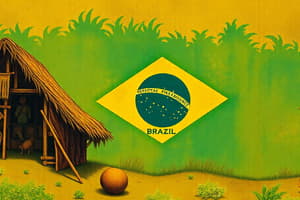Podcast
Questions and Answers
Em 1822, o Imperador Pedro I encerrou três séculos de domínio colonial ______.
Em 1822, o Imperador Pedro I encerrou três séculos de domínio colonial ______.
português
Pedro I estabeleceu várias instituições, como o Senado Imperial e o Conselho ______.
Pedro I estabeleceu várias instituições, como o Senado Imperial e o Conselho ______.
Federal
A abolição da escravidão no Brasil ocorreu em ______.
A abolição da escravidão no Brasil ocorreu em ______.
1888
O filho de Pedro I, Pedro II, assumiu o trono após a sua ______.
O filho de Pedro I, Pedro II, assumiu o trono após a sua ______.
A assinatura da Lei do Ventre Livre pela Princesa Isabel marcou o fim do ______ no Brasil.
A assinatura da Lei do Ventre Livre pela Princesa Isabel marcou o fim do ______ no Brasil.
Após a queda da ______, o Brasil entrou em um período conhecido como a Velha República.
Após a queda da ______, o Brasil entrou em um período conhecido como a Velha República.
Durante a Velha República, o ______ desempenhou um papel proeminente na política.
Durante a Velha República, o ______ desempenhou um papel proeminente na política.
O período de 1902 a 1930 é conhecido como a República do ______ e do Café.
O período de 1902 a 1930 é conhecido como a República do ______ e do Café.
O fim da Velha República ocorreu quando ______ assumiu o poder em 1930 após um golpe militar.
O fim da Velha República ocorreu quando ______ assumiu o poder em 1930 após um golpe militar.
O regime de Vargas foi caracterizado pelo ______ e pela repressão da oposição política.
O regime de Vargas foi caracterizado pelo ______ e pela repressão da oposição política.
Flashcards are hidden until you start studying
Study Notes
Brazil From 1822 to 1930: The Empire of Brazil, Abolition of Slavery, Old Republic, Milk and Coffee Republic, and Regency Period
In the early 19th century, Brazil emerged from Portuguese colonial rule to become an independent empire led by Emperor Pedro I. Over the next century, the country faced significant social, economic, and political changes, culminating in the rise of a military regime in the late 1930s.
Empire of Brazil (1822-1889)
Emperor Pedro I ascended to the throne in 1822, ending three centuries of Portuguese colonial rule. His reign saw the establishment of various institutions, such as the Imperial Senate and the Federal Council, and the introduction of the gold cruzeiro as Brazil's official currency. However, Pedro I abdicated in 1831 due to disagreements with the upper classes, leaving his son Pedro II to assume the throne. Pedro II ruled until his death in 1889, when the monarchy was abolished.
Abolition of Slavery in Brazil (1888)
One of the most significant events during this period was the abolition of slavery in 1888. Although the practice had been outlawed earlier, it wasn't until Princess Isabel signed the Law of Free Womb that children born to enslaved mothers would be free upon reaching maturity. This law effectively ended Brazil's slave trade, although the institution remained in place until the monarchy's collapse in 1889.
Old Republic (1889-1930)
After the fall of the monarchy, Brazil entered a period known as the Old Republic, characterized by political instability and economic challenges. During this time, the military played a prominent role in politics. Several presidents served short terms due to coups and countercoups, making governance difficult. This era also marked the rise of a powerful elite called the cafetão oligarchy, which controlled much of the country's land and commerce.
Milk and Coffee Republic
The period from 1902 to 1930 is often referred to as the Milk and Coffee Republic because of the country's reliance on milk and coffee exports. During this time, Brazil became one of the world's leading producers of both commodities. The government implemented various policies to support these industries, including tariffs on imported dairy products and subsidies for coffee growers. This period saw significant economic growth, but it also led to increased income inequality and environmental degradation due to large-scale farming practices.
Regency Period (1930-1945)
The Old Republic ended when Getúlio Vargas took power in 1930 following a military coup. Vargas served as president until 1934, then returned to office after another military coup in 1937. His regime was characterized by authoritarianism and repression of political opposition. However, he also introduced social reforms, such as minimum wage laws and labor protections, which improved living conditions for many Brazilians. In 1945, Vargas was succeeded by Eurico Gaspar Dutra, marking the end of the regency period and the beginning of a more democratic era in Brazil.
Studying That Suits You
Use AI to generate personalized quizzes and flashcards to suit your learning preferences.



